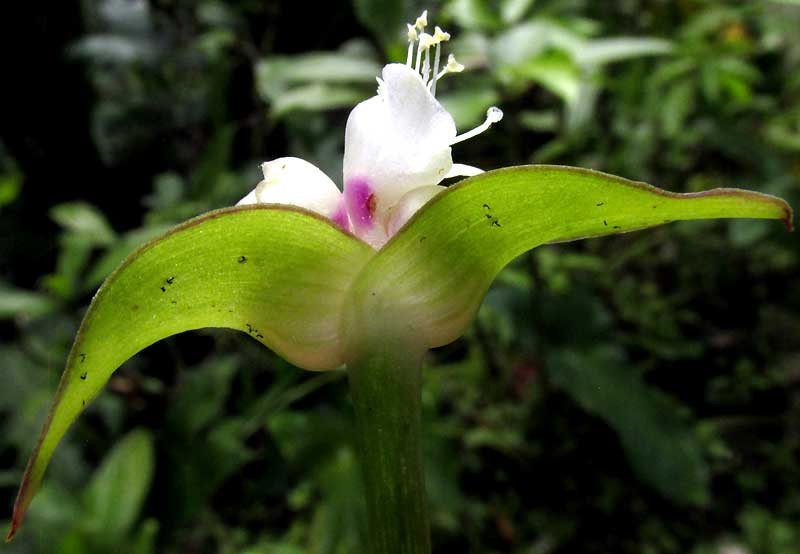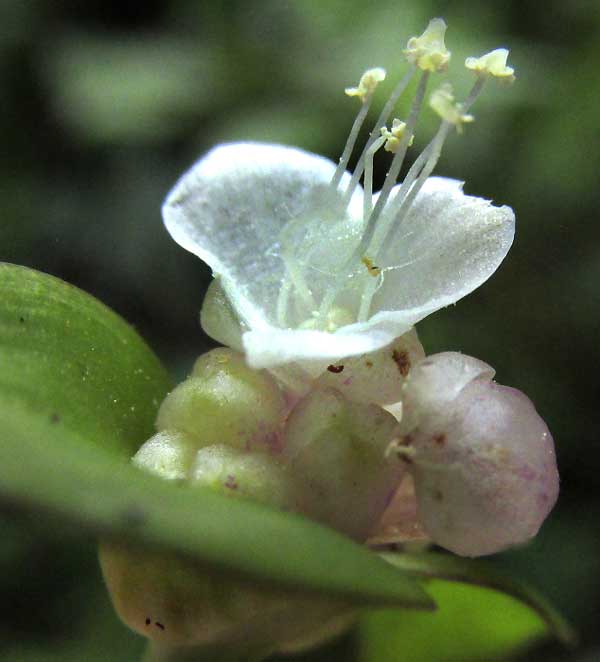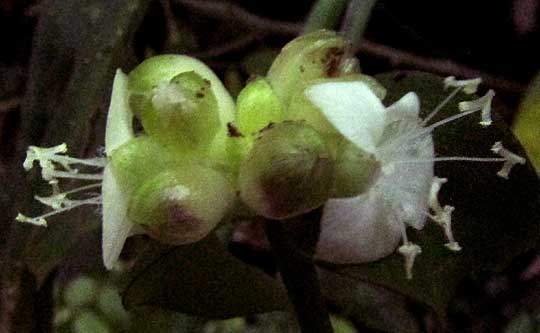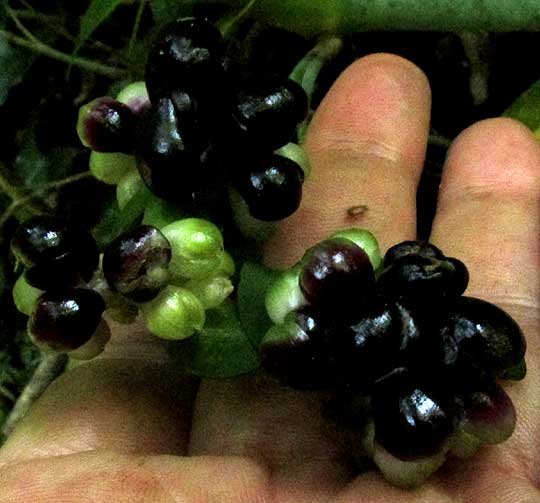Excerpts from Jim Conrad's
Naturalist Newsletter
from the May 4, 2019 Newsletter with notes from an April, 2019 camping trip into northern Guatemala's Petén department; tropical rainforest, elevation ~220m (~720 ft), ~N16.492°, W90.209°
GENTIAN-LEAVED SPIDERWORT
Last month, on April 1, as I wandered forest trails between Maya ruins in Seibal Archaeological Park in northern Guatemala's Petén department, in a treefall area receiving plenty of sunlight, a certain fleshy-leafed herbaceous plant grew rankly, covering the whole opening. One of the plants, clearly a monocot because of its leaves' many fine veins paralleling one another, is shown below:

At the top of that picture some small, white flowers are evident. They're produced atop a long peduncle arising from a stem node, as shown below:

Flowers are packed together in a hollow produced where two modified leaves unite, as shown below:

In the flower cluster, usually only one or two flowers blossom at one time, as shown below:

Each flower bears three petals and six stamens, which is normal for monocot flowers. Dicot flowers usually have their parts in fours or fives, or multiples thereof.
Seeing this arrangement of fleshy monocot herbs bearing flower groups subtended and cupped by modified leaves, we need to think "The Spiderwort Family, the Commelinaceae." Another feature of the Commelinaceae is that the leaf bases normally wrap around the stem, forming a "sheath," and our plant's leaves do that nicely, as shown below:

The Spiderwort Family is a medium-sized one, with about 650 species in around 41 genera, mostly occurring in tropical, subtropical and warm areas. Northerners who pay attention to wildflowers and weeds probably are familiar with two genera in the family: Commelina, in which dayflowers and widow's-tears occur, and Tradescantia, the spiderworts. In size and shape the three petals of Commelina flowers vary conspicuously from one another, while in Tradescantia the petals are all alike. We have a Tradescantia.
Among the 70 or so Tradescantia species -- all American -- ours is fairly easy to distinguish, mostly because of the exceptionally long peduncles bearing flower clusters. Here we have TRADESCANTIA ZANONIA, the Gentian-leaved Spiderwort, which I didn't recognize despite having found it earlier in a chilly, high-elevation cloud forest in southern Veracruz state, in Mexico, back in 2015. That plant is profiled in the next section.
Because the habitats of the two plants so differed from one another, it never occurred to me that the Tradescantia in Veracruz could be the same as this one in very hot, lowland Guatlemala. Apparently this is an adaptable species. But note that despite the different habitats and the geographical distance between them, both populations were flowering in April.
If you do an Internet search on the name Tradescantia zanonia, you'll find few pictures of plants looking like ours and growing in the wild. However, there will be hundreds of images of a strongly variegated basket plant with white and green stripes, commonly sold commercially as "Mexican Flag." I used to grow it myself, but never would have associated the potted plants with our leggy wild plants.

notes from the May 10, 2015 Newsletter describing a camping trip, in the last week of April, in the hydrological reserve above San AndrésTuxtla, Veracruz, México
GENTIAN-LEAVED SPIDERWORT
On my camping trip during the last week of this April, in the mountain-top hydrological reserve above and to the north of San Andrés Tuxtla, Veracruz, Mexico (elevation ~1180m (5900ft), ~N18.52°, ~W95.15°), I met with an interesting spiderwort I'd never seen. It turned up along a deeply shaded trail through the cloud forest, groping toward a sunbeam entering through a break in the canopy above the trail, as shown at the top of this page in a flash-assisted picture.
This spiderwort species was much "leggier" than most -- lots of stem for the number of leaves. Also, as shown below in very dim light, the flowers were smaller than usual, with curious, upside-down-V-shaped anthers attached at their middles:

Remarkably, the plant's capsular fruits were wholly enveloped by fleshy, purplish-black calyxes, as shown below:

Where leaves attached to the stems, a fringed, collar-like affair surrounded the stem, shown below:

With such unusual traits, this spiderwort quickly revealed itself as TRADESCANTIA ZANONIA, sometimes known as Gentian-leaved Spiderwort. The species occurs in moist to wet forests from southern Mexico south to Bolivia and Brazil, as well as the Caribbean area.
Not much is known about the species. It's thought that its capsular fruits may never split open to lose their seeds the normal way but that, rather, birds are attracted by the black, shiny calyxes covering the fruits, and eat the fruit and calyx together, later to disseminate the seeds the usual way.
A cultivar sold under the trade name Mexican Flag and listed as Tradescantia zanonia is strongly variegated with white and green stripes, and close-together leaves, looking very unlike like this wild Tradescantia zanonia. You can see pictures of the cultivar at http://davesgarden.com/guides/pf/go/102116/.